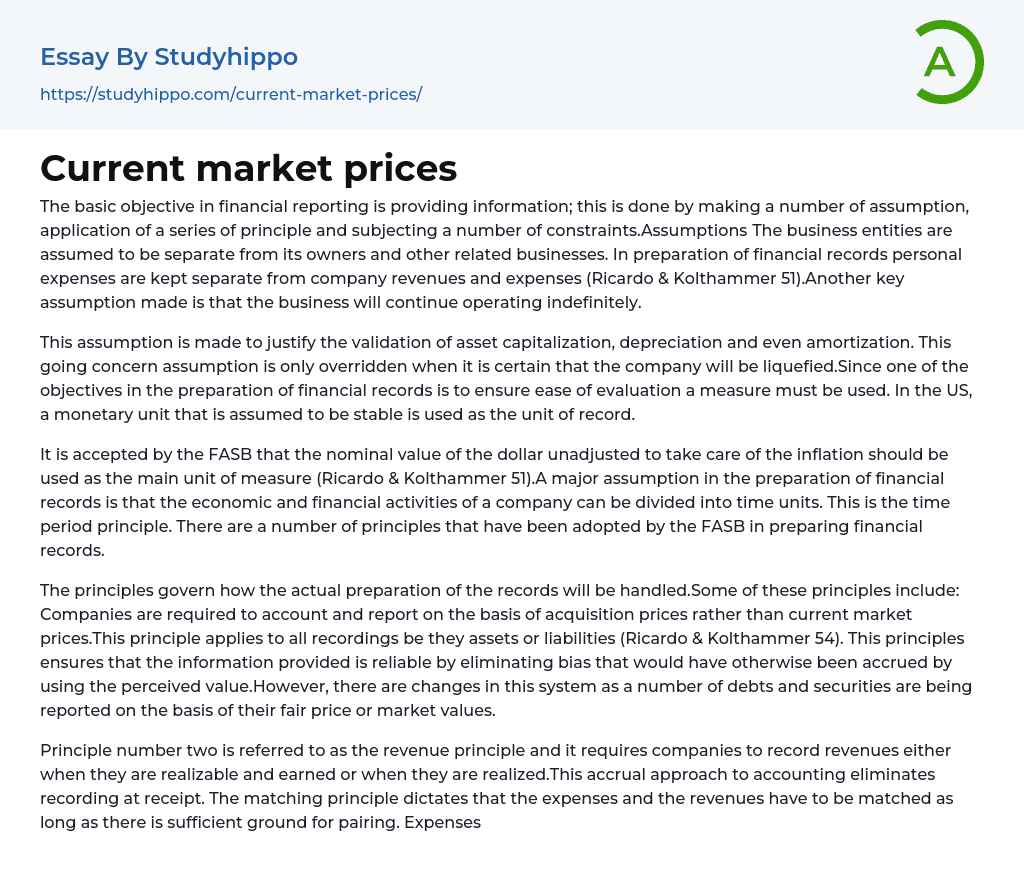Financial reporting aims to provide information through the use of assumptions, principles, and constraints. One such assumption is that business entities are distinct from their owners and other associated enterprises. This separation allows for personal expenses to be separated from company revenues and expenditures (Ricardo & Kolthammer 51). Additionally, a fundamental assumption is that the business will continue to operate indefinitely.
Asset capitalization, depreciation, and amortization are validated based on the going concern assumption. This assumption is set aside only in cases of certain company liquidation. Financial records are prepared with the objective of facilitating evaluation, for which a measure is required. In the US, a stable monetary unit is used for record-keeping purposes.
According to Ricardo and Kolthammer (51), the FASB acknowledges that the nominal value of the dollar without inflation adjustment must
...be utilized as the primary measuring unit. The time period principle is a significant premise in creating financial records, as it assumes that a company's economic and financial activities can be classified into time units. The FASB has adopted numerous principles in the production of financial records.
The principles governing the handling of record preparation include accounting and reporting based on acquisition prices rather than current market prices for all assets and liabilities (Ricardo ; Kolthammer 54). This ensures reliability by eliminating bias from perceived value. However, changes have been made to report certain debts and securities based on fair price or market values.
The revenue principle, also known as principle number two, mandates companies to record revenues when they are either earned and realizable or when they are realized. By following an accrual approach, accounting eliminates recording at the time of receipt.
The matching principle states that expenses and revenues must be matched whenever possible. Expenses only receive recognition when associated products or services create revenue. In case there is no correlation between an expense and revenue, the expenses can be charged in the ongoing period. The principle emphasizes accuracy and robustness while evaluating actual performance and profitability by showing how much was spent to earn a given revenue. The disclosure principle governs the amount of information that can be disclosed.
Based on this principle, the level of information disclosed should be determined through a trade-off analysis. Excessive information can lead to higher costs in financial record preparation and use. Therefore, information presented should be sufficient for making judgments while ensuring lower costs. Financial data can be included in the main statement, notes, or supplementary materials. Constraints are imposed to minimize errors and guarantee reliability in financial reporting.
The financial records should be based on objective evidence according to the objectivity principle (Ricardo ; Kolthammer 54). Reporting an item is the only way to consider its significance. Information is considered significant under the materiality principle if it can affect decisions made by a reasonable person (Ricardo ; Kolthammer 55). Additionally, companies must ensure consistency in their accounting principles year after year.
According to Ricardo ; Kolthammer (55), the wise choice is to prioritize the solution that is expected to underestimate the income and assets when faced with two options.
- Net Present Value essays
- Income Statement essays
- Bank essays
- Banking essays
- Corporate Finance essays
- Credit Card essays
- Currency essays
- Debt essays
- Donation essays
- Enron Scandal essays
- Equity essays
- Financial Accounting essays
- Financial Crisis essays
- Financial News essays
- Financial Ratios essays
- Financial Services essays
- Forecasting essays
- Foreign Exchange Market essays
- Free Market essays
- Gold essays
- Investment essays
- Legacy essays
- Loan essays
- Market Segmentation essays
- Money essays
- Personal finance essays
- Purchasing essays
- Retirement essays
- Shareholder essays
- Stock Market essays
- Supply And Demand essays
- Venture Capital essays
- Accounting essays
- Andrew Carnegie essays
- Automation essays
- Business Cycle essays
- Business Intelligence essays
- Business Model essays
- Business Operations essays
- Business Software essays
- Cooperation essays
- Cooperative essays
- Corporate Social Responsibility essays
- Corporation essays
- Customer Relationship Management essays
- Family Business essays
- Franchising essays
- Harvard Business School essays
- Harvard university essays
- Human Resource Management essays




